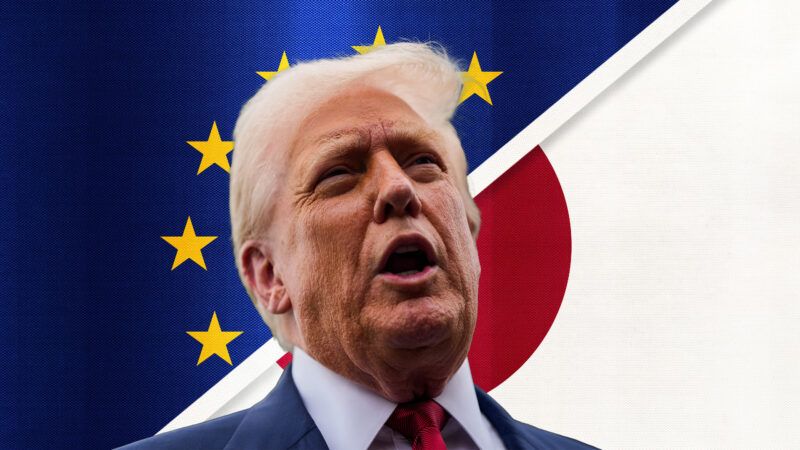The Art of the Empty Trade Deal
Trump’s Japan and E.U. deals offer vague promises and lack the depth and enforceability of the TPP he scrapped.

By its own reckoning, the Trump administration has now inked "the largest trade deal in American history"—twice. On July 22, it announced a deal with Japan, with the promise of $550 billion in direct investment in the United States. Shortly after came the European Union trade deal, which the administration hailed as "historic structural reforms."
All this fanfare over record-breaking trade deals brings to mind the Trans-Pacific Partnership (TPP), which, in its time, was on track to be the globe's largest free trade pact before President Donald Trump abandoned it in 2017. TPP partners represented 40 percent of all U.S. trade, and unlike today's skeletal agreements, we had the details. In fact, we had 30 chapters of them, covering everything from intellectual property to tariffs to e-commerce.
In contrast, the Japan deal that Trump claims to have struck is more puzzle than promise. The White House fact sheet on the new deal claims, "Japan will invest $550 billion directed by the United States to rebuild and expand core American industries," and that 90 percent of the return from investment would go to the United States. However, this language veers in a different direction from the Japanese cabinet release, which says "Japan will enable government-affiliated financial institutions to provide up to $550 billion in capital contributions, loans, and loan guarantees." Council on Foreign Relations Senior Fellow Brad Setser has called the investment pledge "vaporware."
The E.U. deal is, if anything, even thinner on details, with European negotiators rushing to clarify it was only a preliminary framework—political, provisional, and definitely not legally binding.
It didn't have to be this way. The Trump administration claims its tariffs are drawing countries to the table for tough negotiations. Yet in 2016, TPP partners were already there, ready to sign an agreement that closely reflected U.S. trade standards and practices, having overcome significant domestic hurdles. The TPP's multilateral negotiating framework actually provided an efficient mechanism for participating countries to modernize their existing bilateral free trade agreements, and it augmented less comprehensive pacts like NAFTA and the Korea-U.S. agreement (KORUS).
The White House claims its new trade deal with Japan pushed "breakthrough openings" in agriculture and food, but the real groundwork was laid a decade earlier, when Shinzo Abe took on Japan's powerful farm lobby in 2015, clearing the path for the TPP and softening resistance to liberalized agricultural trade. The TPP would have covered virtually all goods, including politically sensitive products like Japanese rice.
The 2025 deal also hardly qualifies as a "free trade deal," with imports from Japan into the U.S. still subject to a 15 percent reciprocal tariff rate. Those tariffs are a tax on American businesses and consumers.
The TPP, by contrast, was slated to roll back 18,000 individual tariffs, making it "the largest tax cut on American exports in a generation."
The deal sets tariffs on Japanese automakers at 15 percent, down from the previously threatened 25 percent, but still a huge hike given that the average U.S. tariff on Japanese goods was previously under 2 percent. Three of the largest U.S. automakers—General Motors, Ford Motor, and Stellantis—quickly pointed out how the deal disadvantaged U.S. automaking, since the cars they make in Mexico and Canada are still subject to the 25 percent tariff rate. The deal also reduces the incentive for companies like Toyota to build in America, where they would face this 25 percent component rate and tariff-hiked steel prices. Under the TPP, the U.S. would have completely phased out auto tariffs on Japan over 25 years. Slow as that was, it still beat the bleak reality of today's protectionist 15 percent tariffs.
Building trade policy on headline‑driven, ad hoc bargains is an unstable strategy—made more precarious when the very tariffs they hinge on rest on contested executive authority. These arrangements may create the illusion of momentum, but without enforceable commitments or structural durability, they offer little of the stability that comprehensive trade agreements provide. The TPP demonstrated how a well‑designed pact could lock in reforms, deepen alliances, and shape the rules of global commerce for decades. Washington's drift toward improvisation risks ceding that ground to others who are willing to play the long game—and win it.
